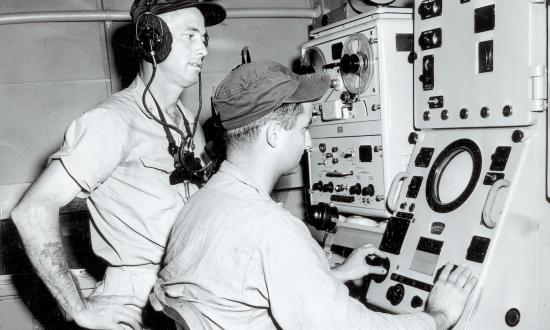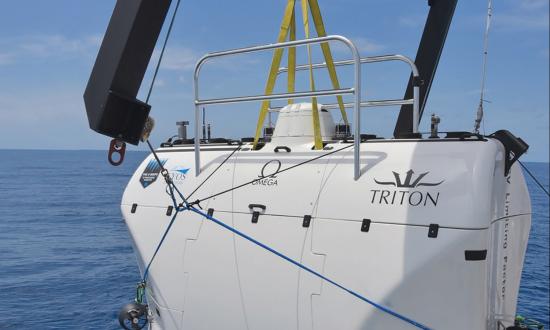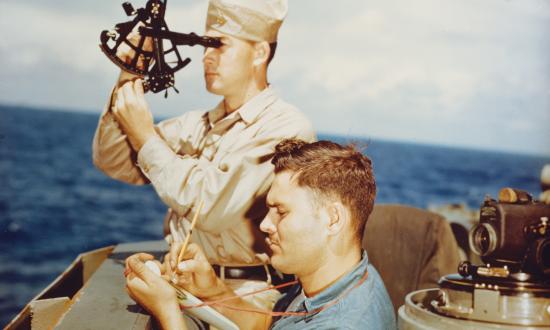As sailors and Marines, we often use professional forums such as Proceedings to cross-connect technical, sociological, and geopolitical knowledge. But what about our younger citizens who have yet to serve their country, be it in the military or as a civilian? At what point should they be introduced to the non-Hollywood realities of defense-related subjects? Tom Cruise only flies if engineering and supply keep him and his aircraft going. Johnny and Mary can point to the Arctic Ocean on a globe, but do they know how an ice-free Arctic affects global economics and politics?
Understanding basic concepts of time, distance, transportation, communications, and logistics should be part of young Americans’ seabags. Shipmates, why not transfer some of our (age-appropriate) real-world experience to the kids in our families and communities?
In 1994, after almost 29 years of naval service, I became a high school teacher. It was a good fit for me, and I did it for 11 years before retiring in 2005. Since then, thanks to the luxury of good health and location, I have enjoyed annoying my four grandchildren (ages 10 to 20) with Socratic, kitchen-table lessons. Of course, because I have the highest lineal number in our family wardroom, I get to choose the topics. My lessons are akin to tips on how to make sense of our fast-changing technological and geopolitical world and help give the young ones a psychic edge over their peers. By psychic edge, I mean giving them the self-confidence that comes from knowing key elements of the big picture, trusting the right sources, and thinking critically about cause and effect.
Kids are unlikely to get such tips in school. I know. I have been there. The limitations of state-mandated curricula and administrative overhead constrain most teachers’ ability to show kids how the real world works. But I know that practical examples of problem solving, analysis, and postulating outcomes will help my grandchildren in their future pursuits, especially if they aspire to be leaders in military or civilian life.
Think of the education process as coaching. You present an age-appropriate problem, give some guidance (fundamentals), and then let the young one try to figure it out. My father, a Bureau of Ships civilian engineer during World War II, was good at this. We both liked the TV show The Twilight Zone. In one episode, a scientist travels back in time to the 1880s but is frustrated by the absence of cathode-ray tubes. I asked what those were, and Dad said, “You’re looking at one.”
Then he challenged me: “Look it up in the encyclopedia.”
This happened in 1963, when a transistor radio was the only personal e-device and a 20-volume Encyclopedia Britannica was our internet. Scanning volume Ca–Cz, I got the gist of how our 15-inch Philco worked, but my Dad upped the learning ante by introducing me to a friend who worked at a TV station in Washington, D.C., and who also was a HAM radio operator. A behind-the-scenes tour of the TV studio and a late-night session exchanging call signs with folks in Australia and suddenly I knew something about photons, electron guns, vacuum-tube heat, and the propagation of nighttime skywaves.
My father had given me a gift of information to put in my knowledge toolbox/seabag that might come in handy someday.
Two years later I was a seaman apprentice at Submarine School. The hands-on curriculum (including underway time on Balao-class diesel subs) introduced me to all manner of electro-mechanical devices and the physical properties of fuel, air, and water. Unlike me, some of my classmates had attended vocational high schools or had grown up working on cars and had an easier time grasping mechanical concepts. But I got through it, and soon my pre-knowledge of skywaves and cathode tubes helped me, a quartermaster striker, grasp electronic navigation systems.
Fast forward. A couple of years after Desert Storm, I retired as a commander and joined a public school faculty with about six other newly retired officers and noncommissioned officers. We were from various warfare specialties. I had the odd combination of diesel subs, carrier aviation, and naval intelligence. The others had been corpsmen, ship drivers, aviators, and even a Marine tank commander. We stuck out like sore thumbs—and not just because we wanted to take care of maintenance problems without waiting for Public Works.
We stuck out because of our demonstrated knowledge of things that were not in the curriculum. In the teacher workroom or lunchroom, our scuttlebutt confused and intrigued other faculty members. They looked at us as if we were brilliant! Now, I had known some true Einsteins in the Navy, and I wasn’t one by a long shot. So how was it possible to impress professional educators?
Because our “you-had-to-be-there” sea stories touched on meteorology, air-traffic control, the electromagnetic spectrum, acoustics, logistics, law enforcement, hydrodynamics, aerodynamics, firefighting, fiber optics, orbital mechanics, stealth, sanitation, medical triage, and even escorting foreign heads of state. And, of course, camaraderie, trust, and leadership. All of us admitted to straying from the curriculum to impart some real-world gouge that held the students’ attention and likely generated interesting dinner discussions with their parents or guardians.
Our service, training, and mentors had given us old seadogs the gift of real-world, multidisciplinary education that so few professional educators get to experience. Such a unique gift needs to be shared with our next generation—one that uses technology voraciously but doesn’t understand how it works or care to know how it was developed. And it is a generation with little understanding of the ever-changing geospatial relationships that are the essence of geographic literacy—not just where things are located at the moment.
The kids who are receptive to learning the hows and whys of things will have that psychic edge I mentioned earlier. The young are very receptive to relevant information. Which brings me to my challenge to current and former Sea Service members: Take the initiative to invite our youth to learn things from you that give them a leg up on the other guy or gal who uses technology but does not understand it. It is not easy.
I observed my grandchildren with an iPhone, turning it from horizontal to vertical to view pictures. The image flips. “How does the picture flip?” I ask. A shrug is the wrong answer for this granddad, and a few days later, after being challenged to find the answer, they sheepishly whisper, “It flips because it has an accelerometer inside.” Thus starts another kitchen or back porch ice-cream-augmented lesson and an introduction to atomic clocks, time-distance of arrival, and the history of GPS (just enough to plant a seed of curiosity; Tomahawks, Harpoons, and over-the-horizon targeting can wait).
I learned a lot about education over the years, and one thing is clear: The mind learns best when it is ready to receive, but the mind often needs a nudge. Sending a young person the right invitation to learn at the right time is a challenge. Self-learning is great, but a coach is needed to ensure the material is accurate and there is a purpose and connection to other things. The subject area is not limited to science and technology but also can include art, language, music, history, sociology, and literature.
Proceedings does this in nearly every issue. I admit I first turn to “From the Archive” to view the archive photo and reflect on what the image conveys to me about history, tradition, and afloat experience.
So, if you can, set aside some time (and gedunk) to pass along a bit of real-world education to a future noncommissioned officer, lieutenant (j.g.), GS-9, or teacher. They may resist putting down their iPhones while you dog and pony how GPS works, why China covets the Scarborough Shoals, or the daily supply needs of a Marine amphibious ready group, but they—and America—will benefit.






